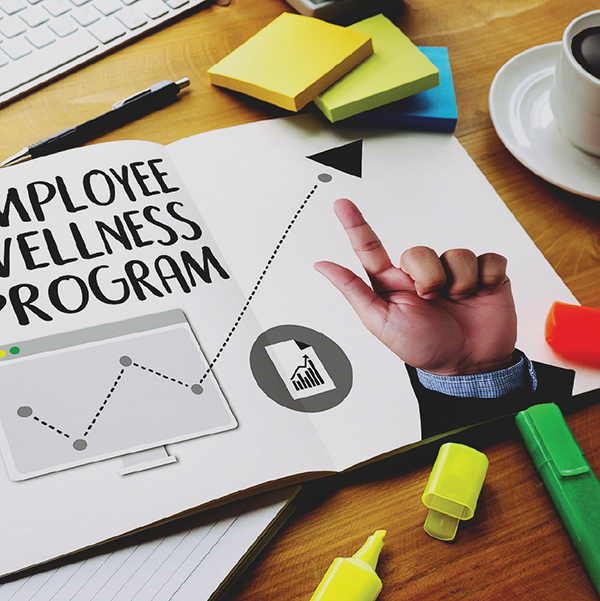Employee wellness programs burst onto the scene with a promisethat was too good to pass up:
|Healthier employees = reduced insurance costs, greaterproductivity and higher profits.
|The good news is a well-executed wellness program can deliver onthis lofty objective, says Hans Hage, vice president of productdevelopment for StayWell in St. Paul, Minnesota.
|“Every indication we have supports the conclusion that employeewell-being programs can have a positive financial impact on acompany, when implemented in a comprehensive way, using bestpractices,” he says. “Most studies report break-even returns orbetter after two or more years of program implementation, andseveral studies suggest a $3 return for every $1 invested in theprogram after three-and-a-half years.”
|However, some employers become discouraged if they don't see animmediate, quantifiable return on their investment. This is whymany industry leaders now recommend a new paradigm that looksbeyond just dollars and cents.
|“More and more, employers are focused on outcomes, but thoseoutcomes are increasingly expanding beyond reduction in wellnesscosts,” Hage says. “With the aging boomer workforce and the need toattract and retain top millennial talent, more employers arelooking for structured choices with their program offering. Whatthis equates to is an emphasis on total well-being—increasingproductivity and retention, decreasing absenteeism, and looking atemployees as valuable investments that they want to see learn andgrow.”
|Beyond ROI
|This means a broader focus not only on ROI, but also on whatHage calls VOI—value on investment. These metrics can be difficultto measure in the short run, but can have a significant impact on acompany's fortunes over the long haul. Wellness programs can:
Support recruitment
Build employee loyalty and retention
Increase collaboration
Improve job satisfaction
Reduce costs related to absenteeism and on-the-job productivityloss
Improve individual and organizational performance
Jared Smith, national partnership manager for Interactive HealthInc. in Chicago, cautions against simplistic models that attempt tocorrelate wellness initiatives with specific dollar figures.
|“There are many wellness vendors out there that claim to showROI,” he says. “However, many of their models and methodologies arecomplex, based upon assumptions that do not provide sufficientquantitative evidence to substantiate their claims. The best way toaddress the conversation and concerns around ROI is to shift thefocus of the discussion to cost avoidance and risk migration,concentrating on key conditions.”
|Brad Cooper, CEO of US Corporate Wellness in Littleton,Colorado, agrees.
|“The data on ROI and VOI are well documented,” he says.“Unfortunately, some in the industry have exaggerated the numbers,but info on aspects like sick time, turnover, ER use, EAPengagement and satisfaction are readily available for anyorganization willing to track the data.
|“However, I have yet to meet a single person who doesn't agreethat if they were to make marginally positive changes with theirsleep, stress, activity levels, fueling choices and other coreareas of wellness, they would be more effective employees. So thequestion becomes, 'How can we help our team members make positivechanges in these areas?' If we do, we not only improve our bottomline, we improve the lives of our employees.”
|
It is easy to be sidetracked in trying to measure variables thatultimately are not all that relevant to a company's objectives.“Measurement of a wellness program is an important part of theplanning process and should be directly related to the goals of theprogram,” says Amy McDonough, senior vice president of strategy andoperations for Fitbit Health Solutions in San Francisco.
|Employers should monitor the factors that are important tothem.
|“For some employers, increasing employee satisfaction is thegoal,” she says. “For others, it's lowering health care costs.Regardless of your goal, setting up the measurement process beforeyou get started can be helpful in measuring success.
|“For example, if you are creating a program to boost employeesatisfaction, you might consider a survey of employees before andafter the program. If you're looking to create a program aimed atimproving health outcomes, you may want to consider includingbiometric screenings as part of your program. Each wellness programis unique, and so are the metrics which determine success, but witha little planning, measurement can not only determine ROI, but canhelp build even more successful programs in the future.”
||
What goes around, comes around
|Interestingly, as more companies move toward VOI models that gobeyond the bottom line, new research shows that approach is, infact, contributing to profitability.
|“For the past several years now, employers have begun to realizethat investing in well-being can deliver more than just health carecost savings,” says Jessica Grossmeier, Ph.D., vice president ofresearch for Health Enhancement Research Organization (HERO) inWaconia, Minnesota. “There is now less of a focus on the financialimpact represented by traditional ROI models and more of a focus onworkforce engagement, productivity and overall businessperformance.
|“In fact, a 2016 research study from HERO found there is acorrelation between companies that invest in comprehensiveapproaches to employee well-being and those that report strongcorporate stock performance. The conversation has thus shifted froma focus on ROI alone to a broader value proposition that includesboth the tangible and intangible benefits of improved worker healthand well-being.”
|The best measuring stick for a successful wellness program maynot be the overall company, but the individual employee. Eachworker starts at a different point and has different objectives. Ifthey continue to make progress, however small, the program can beconsidered successful.
|“Wellness has historically been seen as a tool to turn everyoneinto marathon-running, salad-eating yoga participants,” Coopersays. “The real key to an effective employee wellness strategy is#BetterThanYesterday. Let's stop trying to turn me into you. Let'scome alongside our team members in a confidential manner and helpthem make their tomorrow just a little bit better than theirtoday.
|“If we repeat that day after day and month after month, we'rereally going to improve lives, aren't we? So yes, anything thatimpacts my well-being can enhance the process. That may includefinances, stress, nutrition, life balance, relationships, activitylevels, or a vast number of other components. Wellness isn't a'module' we complete. Rather, it's a life we live—better.”
|Perhaps the biggest challenge, as well as the greatestopportunity, lies in creating a corporate culture of wellness. Themost important asset is people, who in turn are supported withreliable data.
|“Employers are investing in worksite wellness programs toembrace a culture change supported by leadership and use data todrive strategy to achieve a healthy workforce,” Smith says. “Theculture must be embraced in thought and action through a grassrootsapproach by all members of the organization.”
|
Companies that focus on building such a culture and engagingtheir employees are more likely to see the desired ROI and VOIresults.
|“Personalize your wellness program based on the needs of yourcompany and your employees,” McDonough says. “Take time to learnabout your population and then develop your wellness program tomeet your population's needs.”
|The new equation is just as compelling as the old one:
|Healthy corporate culture = maximum value oninvestment.
|“Elevating employee health and well-being to the level ofbusiness strategy and approaching it from a comprehensive, systemicperspective is key to achieving success with well-being programs,”Grossmeier says. “By understanding the broader value improvedwell-being can have on a company's overall performance andinvesting in strategies and technologies that support totalwell-being, employers can create engagement in and support foremployee health in the workplace and in the broader community.”
|Rules of engagement: Industry leaders share theirinsights
|Forgive employers if they are getting a little burned-out on theword “engagement:”
|“Employee engagement is one of those buzzwords that is painfullyoverused and infrequently understood in our industry,” says HansHage, vice president of product development for StayWell.
|Nevertheless, he suggests three necessary elements forsuccessful employee engagement in a wellness program:
A supportive culture which lives and breathes its core mission,values and principles;
Clear and consistent communications that reach participantswhere they are with tailored and relevant prompting;
And appropriate incentives, whether intrinsic or extrinsic, tomotivate the population.
Other industry leaders also share their insights on maximizingemployee engagement and, therefore, both ROI and VOI:
|“The single best way to increase engagement is throughpersonalized, relationship-oriented wellness coaching. Yes, it'smore costly than clicking into a website. But if done well, itprovides the opportunity to create meaningful, lasting change forthe employee in an area that matters to her or him.”
|—Brad Cooper, CEO, US Corporate Wellness
|“In our experience, you need to give employees tools that theyalready want to use to increase engagement in wellness programs.Financial incentives are also a great way to boost engagement rateswhen done well and aligned with program goals.”
|—Amy McDonough, senior vice president of strategy andoperations, Fitbit Health Solutions
|“Mandating that employees participate in wellness programs canbe ineffective and costly. Successful innovative strategies includethe use of strategic incentive structures, web-based tools andactivity-based programs that participants can access where andwhenever they want.”
|—Jared Smith, national partnership manager, InteractiveHealth Inc.
|“Wellness programs no longer focus solely on improving keybiometrics. Forward-thinking employers now include elements likeemotional health, financial well-being, professional developmentand community health, because these factors can affect—positivelyor negatively—an individual's performance on the job. This shift toa broader focus has the potential to increase participation,because the organization is meeting a more comprehensive set ofneeds.”
|—Jessica Grossmeier, Ph.D., vice president of research,HERO
Complete your profile to continue reading and get FREE access to BenefitsPRO, part of your ALM digital membership.
Your access to unlimited BenefitsPRO content isn’t changing.
Once you are an ALM digital member, you’ll receive:
- Critical BenefitsPRO information including cutting edge post-reform success strategies, access to educational webcasts and videos, resources from industry leaders, and informative Newsletters.
- Exclusive discounts on ALM, BenefitsPRO magazine and BenefitsPRO.com events
- Access to other award-winning ALM websites including ThinkAdvisor.com and Law.com
Already have an account? Sign In
© 2024 ALM Global, LLC, All Rights Reserved. Request academic re-use from www.copyright.com. All other uses, submit a request to [email protected]. For more information visit Asset & Logo Licensing.








